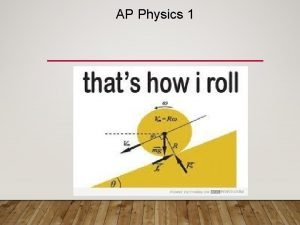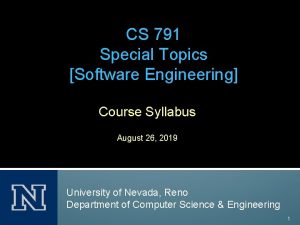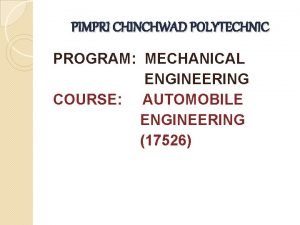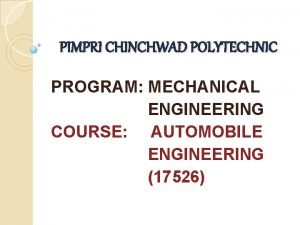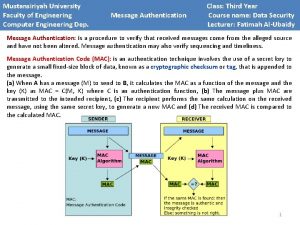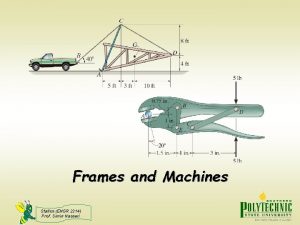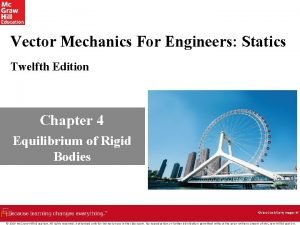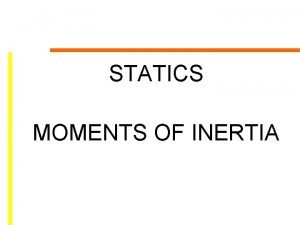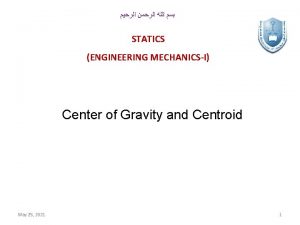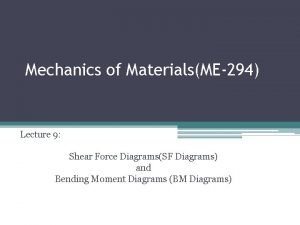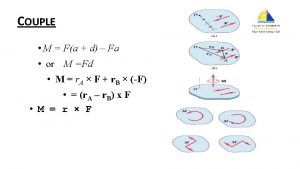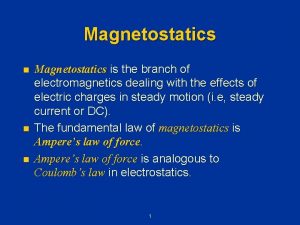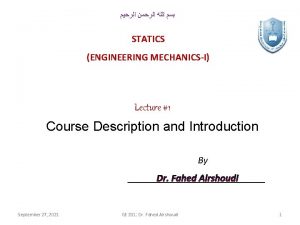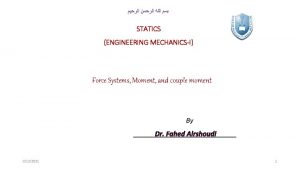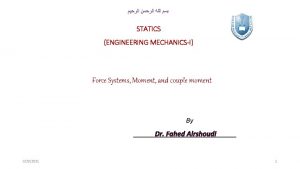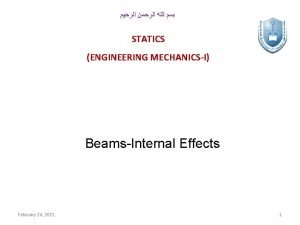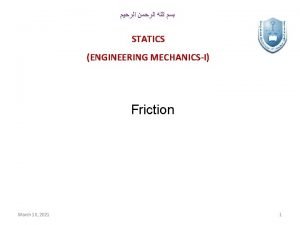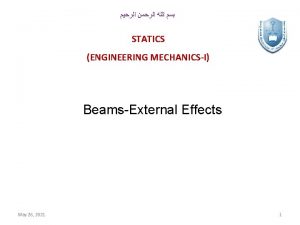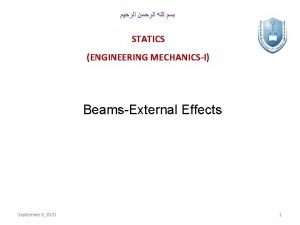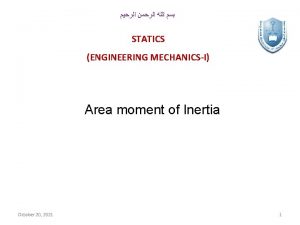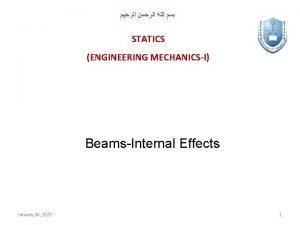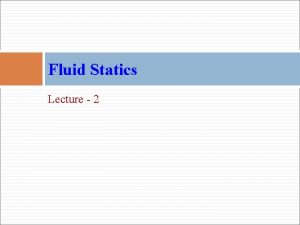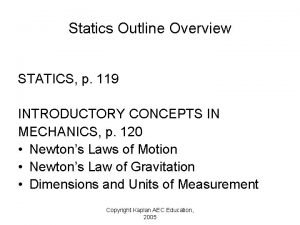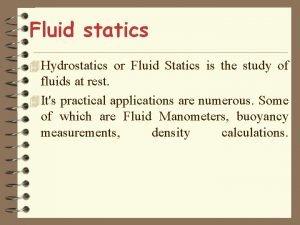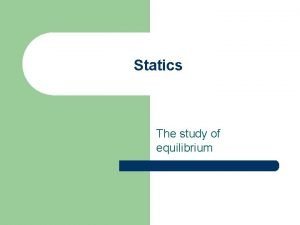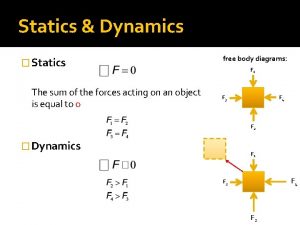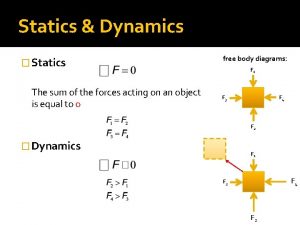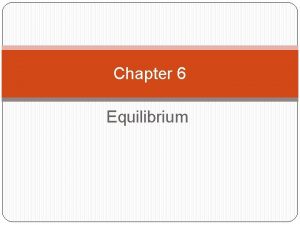STATICS ENGINEERING MECHANICSI Lecture 1 Course Description and





































- Slides: 37

ﺑﺴﻢ ﺍﻟﻠﻪ ﺍﻟﺮﺣﻤﻦ ﺍﻟﺮﺣﻴﻢ STATICS (ENGINEERING MECHANICS-I) Lecture #1 Course Description and Introduction By March 4, 2021 GE 201: Dr. Fahed Alrshoudi 1

Objectives of the Present lecture • • To give an induction of the class policy To provide statistics numbers To provide an overview of the course contents To explain the learning outcomes of the present course To provide important dates To explain what the “Statics” is. To define scalar and vector quantities To provide an overview of most common vector operations March 4, 2021 GE 201: Dr. Fahed Alrshoudi 2

About the Instructor Name: Dr. Fahed Alrshoudi Designation: Assistant Professor Department: Civil Engineering Office: 2 A 69 Email: falrshoudi@ksu. edu. sa Website: http: //fac. ksu. edu. sa/falrshoudi Office Hours: Displayed on the office wall. March 4, 2021 GE 201: Dr. Fahed Alrshoudi 3

Class Rubric • No tick attendance after 10 min of the beginning of lecture. • No Phone • Email!!! • Bonus • Free to get in or out of the classroom • Attendance (90%)

Statistic Numbers Number of Students A+ A B+ B C+ C D+ D F 85 3 7 10 10 13 14 10 6 12 % 12 24 32 19 14

A+ and A, How?

Fail (F), Why? 1 st Mid 2 nd Mid 22. 5 13. 75 14 12. 25 22. 5 10. 5 8. 5 9 MD Tut Total sem. 5 10 60 0 5 5 5 Final Mark Total #Absent 29. 25 20. 2 49. 45 8 4 31. 5 20. 4 51. 9 10 0 26. 25 28. 8 55. 05 10

Course Description • Force systems; vector analysis, moments and couples in 2 D and 3 D • Equilibrium of force systems • Analysis of structures; plane trusses and frames. • Distributed force system • Centroid of simple and composite bodies • Area moments of inertia • Analysis of beams • Friction March 4, 2021 GE 201: Dr. Fahed Alrshoudi 8

Course Learning Outcomes Students completing this course will be able to • Analyze 2 D and 3 D force system and calculate moment in a 2 D and 3 D structures • Analyze beam, and frame structures using equilibrium equations • Analyze truss structures using various methods • Locate centroid of regular and composite cross sections • Evaluate area moment of inertia of engineering cross sections about different axes. • Analyze and solve friction related equilibrium problems March 4, 2021 GE 201: Dr. Fahed Alrshoudi 9

Text Book STATICS • Authors: JL Meriam & LG Kraige • Publisher: John Wiley & Sons. • Edition: Seventh (in SI Units) March 4, 2021 GE 201: Dr. Fahed Alrshoudi 10

Outcome Assessment • Two Midterm Exams • Model Demonstration and Report Writing • Tutorial and Homework • Final Exam March 4, 2021 GE 201: Dr. Fahed Alrshoudi 45% 5% 10% 40% 11

Midterm Exams • • First Midterm Date: 15 Shawwal 1437 H (20 July 2016) Day: Wednesday Time: 7: 00 – 8: 30 pm Second Midterm Date: 29 Shawwal 1437 H (03 August 2016) Day: Wednesday Time: 7: 00 – 8: 30 pm • Final Exam • Date: 15 - Thul-Qedah (18 -August) • Day: Thursday March 4, 2021 GE 201: Dr. Fahed Alrshoudi 12

Engineering Mechanics A branch of science concerned with the action of forces on material bodies in rest or in motion • Categories of Mechanics: -Rigid bodies -Statics (deals with equilibrium of bodies at rest) -Dynamics (deals with the accelerated motion of bodies) -Deformable bodies -Fluids March 4, 2021 GE 201: Dr. Fahed Alrshoudi 13

A Real Life Application Engineering Design of a building is an application of Statics knowledge. Design of its various components are primarily based on the Principles of Static equilibrium and Strain compatibility. March 4, 2021 GE 201: Dr. Fahed Alrshoudi 14

Newton’s Laws • Law I: If the resultant force on a particle is zero, the particle will remain at rest (if originally at rest) or will move with constant speed in a straight line (if originally in motion). • Law II: The acceleration of a particle is proportional to the resultant force acting on it in the direction of this force. – If above Law (II law) is applied to a particle of mass m, it may be stated as • Law III: The forces of action and reaction between interacting bodies are equal in magnitude, opposite in direction, and collinear. March 4, 2021 GE 201: Dr. Fahed Alrshoudi 15

Weight of the body • The gravitational attraction of the earth on a body is known as the weight of the body. This force exists whether the body is at rest or in motion. • Since this attraction is a force, the weight of a body should be expressed in Newtons (N) in SI units and in pounds (lb) in U. S. customary units. • Note: Unfortunately in common practice the mass unit kilogram (kg) has been frequently used as a measure of weight. This usage should disappear in time because in SI units the kilogram is used exclusively for mass and the Newton is used force, including weight. March 4, 2021 GE 201: Dr. Fahed Alrshoudi 16

Law of sines and cosines Law of sines March 4, 2021 Law of cosines GE 201: Dr. Fahed Alrshoudi 17

ENGINEERING MECHANICS : STATICS Systems of Units • International System of Units (SI) or Metric • The unit of Force is derived as below, System : The basic units of length, time, and mass which are defined as meter (m), second (s), and kilogram (kg). March 4, 2021 GE 201: Dr. Fahed Alrshoudi 18

U. S. Customary UNITS • U. S. Customary units (or foot-pound-second (FPS) units): – Mass : slugs ( No symbol) – Length: foot (symbol ft) – Time: second (symbol sec) – Force: pound ( symbol lb) • Note: In U. S. units the pound is also used on occasion as a unit of mass. When distinction between the two units is necessary, the force unit is frequently written as lbf and the mass unit as lbm. • Other units of force in the U. S. system which are in frequent use, are the kilopound (= 1000 lb), and the ton (= 2000 lb) March 4, 2021 GE 201: Dr. Fahed Alrshoudi 19

ENGINEERING MECHANICS : STATICS SCALAR QUANTITIES A scalar is a quantity that has only magnitude, either positive or negative. For example; mass, length, area, volume and speed are the scalar quantities frequently used in Statics. SCALARS Scalars. AND are. VECTORS indicated as the scalar ‘A’. 1 - 20 by letters in Itallic type, such

ENGINEERING MECHANICS : STATICS VECTOR QUANTITIES A vector is a quantity that has both a magnitude and a direction. For example; weight, force, moment, velocity and acceleration are the vector quantities frequently used in Statics. Vectors are indicated SCALARS AND VECTORS by bold letters, such as ‘A’ or A The magnitude of a vector is always a positive quantity 1 - 21

ENGINEERING MECHANICS : STATICS Scalars and Vectors 1 - 22

ENGINEERING MECHANICS : STATICS Fundamental Principles – Paralellogram Law & Transmissibility Vectors must obey the parallelogram law of combination. This law states that two vectors A and B, treated as free vectors, may be replaced by their equivalent vector (A+B), which is the diagonal of the parelellogram formed by A and B as its two sides, as shown in the figure. • Principle of Transmissibility Conditions of equilibrium or motion are not affected by transmitting a force along its line of action. NOTE: F and F’ are equivalent forces. 1 - 23


Polygon Rule: can be used for the addition of more than two vectors. Two vectors are actually summed and added to the third and so on. . . P + Q + S = (P + Q) + S = P + (Q + S) This is the Associative Law of Vector Addition


ENGINEERING MECHANICS : STATICS 1 - 27


ENGINEERING MECHANICS : STATICS 1 - 29

ENGINEERING MECHANICS : STATICS 1 - 30

ENGINEERING MECHANICS : STATICS 1 - 31

Unit Vector(s) Cartesian or Standard Unit Vectors March 4, 2021 GE 201: Dr. Fahed Alrshoudi 32

Direction Cosines 3/4/2021 GE 201: Dr. Fahed Alrshoudi 33

ENGINEERING MECHANICS : STATICS 1 - 34

ENGINEERING MECHANICS : STATICS 1 - 35

Vector Multiplications • Dot or Scalar Product • Cross or Vector Product The cross product of the two vectors is defined as a vector with magnitude AB sinθ and a direction specified by the right hand rule. 3/4/2021 GE 201: Dr. Fahed Alrshoudi 36

Position Vector A position vector locates one point in space relative to another. is a position vector that runs from point A to another point B. 3/4/2021 GE 201: Dr. N. A. Siddiqui 37
 01:640:244 lecture notes - lecture 15: plat, idah, farad
01:640:244 lecture notes - lecture 15: plat, idah, farad Engineering mechanics: statics in si units answers
Engineering mechanics: statics in si units answers Two dimensional force system
Two dimensional force system Apwh course and exam description
Apwh course and exam description Course title and course number
Course title and course number Ap physics 1 course description
Ap physics 1 course description Half brick wall in stretcher bond
Half brick wall in stretcher bond Course interne course externe
Course interne course externe Financial engineering lecture notes
Financial engineering lecture notes Software engineering lecture notes
Software engineering lecture notes Foundation engineering lecture notes
Foundation engineering lecture notes Professional ethics in engineering notes
Professional ethics in engineering notes Software engineering course syllabus
Software engineering course syllabus Internet engineering course
Internet engineering course Reksos adalah
Reksos adalah Mechanical engineering course
Mechanical engineering course Mechanical engineering course
Mechanical engineering course Radar systems engineering course
Radar systems engineering course Computer engineering course
Computer engineering course Software engineering 1 course outline
Software engineering 1 course outline Software engineering uottawa course sequence
Software engineering uottawa course sequence Forward engineering in software engineering
Forward engineering in software engineering Machines statics
Machines statics Left portion of the roof truss shown cut by section a-a
Left portion of the roof truss shown cut by section a-a System procurement process in software engineering
System procurement process in software engineering Engineering elegant systems: theory of systems engineering
Engineering elegant systems: theory of systems engineering Elegant systems
Elegant systems Forward and reverse engineering
Forward and reverse engineering Statics of rigid bodies
Statics of rigid bodies Moment of inertia equation statics
Moment of inertia equation statics Centroid problems engineering mechanics
Centroid problems engineering mechanics Engineering mechanics
Engineering mechanics Phy 221 msu
Phy 221 msu Persiapan intubasi statics
Persiapan intubasi statics Embedded beam
Embedded beam Couple moments statics
Couple moments statics Log roll
Log roll Fundamental laws of magnetostatics
Fundamental laws of magnetostatics





